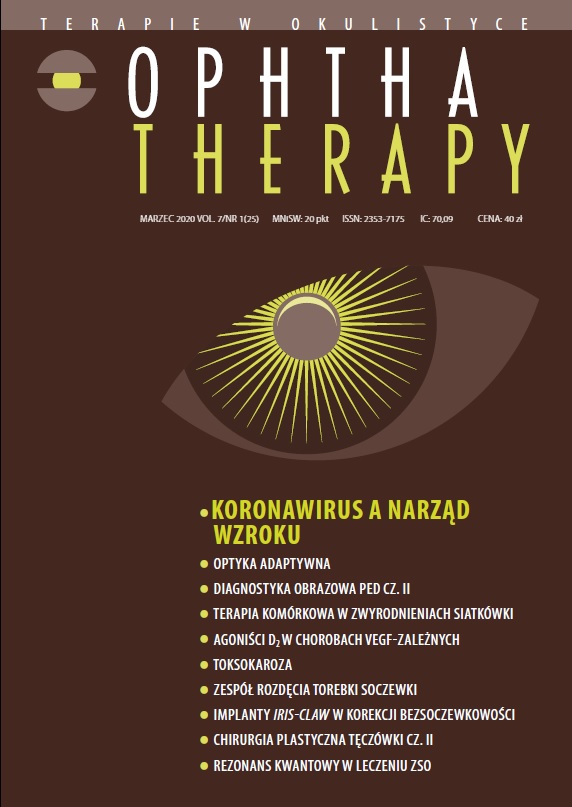Adaptive optics: a new technology in diagnostic imaging Review article
Main Article Content
Abstract
The adaptive optics (AO) technology has become a valuable diagnostic tool in vision research for studying retinal microscopic structure and function. It is an infrared adaptive optics retinal camera that allows non-invasive visualization of cone photoreceptor cells, the retinal vessel wall and lumen diameter, nerve fibers, and structure of lamina cribrosa, that remain invisible with other current diagnostic techniques. The AO technology may provide information about the pathologic changes in the retina, even in the absence of structural or functional abnormalities in the current diagnostic imaging. The rtx1TM (Imagine Eyes, France) is the only AO imaging device that has received regulatory clearance for ophthalmic examinations in multiple countries. In this article we present a brief overview of AO development, and its evolving range of applications in ophthalmic diagnostics.
Downloads
Article Details

This work is licensed under a Creative Commons Attribution-NonCommercial-NoDerivatives 4.0 International License.
Copyright: © Medical Education sp. z o.o. License allowing third parties to copy and redistribute the material in any medium or format and to remix, transform, and build upon the material, provided the original work is properly cited and states its license.
Address reprint requests to: Medical Education, Marcin Kuźma (marcin.kuzma@mededu.pl)
References
2. Zaleska-Żmijewska A, Piątkiewicz P, Śmigielska B et al. Retinal photoreceptors and microvascular changes in prediabetes measured with adaptive optics (rtx1™): a case-control study. J Diabetes Res. 2017: 1-9.
3. Soliman MK, Sadiq MA, Agarwal A et al. High-Resolution Imaging of Parafoveal Cones in Different Stages of Diabetic Retinopathy Using Adaptive Optics Fundus Camera. PLoS One. 2016; 11(4): e0152788.
4. Koch E, Rosenbaum D, Brolly A et al. Morphometric analysis of small arteries in the human retina using adaptive optics imaging: relationship with blood pressure and focal vascular changes. J Hypertens. 2014; 32(4): 890-8.
5. Rosenbaum D, Mattina A, Koch E et al. Effects of age, blood pressure and antihypertensive treatments on retinal arterioles remodeling assessed by adaptive optics. J Hypertens. 2016; 34(6): 1115-22.
6. Errera MH, Laguarrigue M, Rossant F et al. High-Resolution Imaging of Retinal Vasculitis by Flood Illumination Adaptive Optics Ophthalmoscopy: A Follow-up Study. Ocul Immunol Inflamm. 2019; 1: 1-10.
7. Errera MH, Coisy S, Fardeau C et al. Retinal vasculitis imaging by adaptive optics. Ophthalmology. 2014; 121(6): 1311-2.e2.
8. Zwillinger S, Paques M, Safran B et al. In vivo characterization of lamina cribrosa pore morphology in primary open-angle glaucoma. J Fr Ophtalmol. 2016; 39(3): 265-71.
9. Paques M, Meimon S, Rossant F et al. Adaptive optics ophthalmoscopy: Application to age-related macular degeneration and vascular diseases. Prog Retin Eye Res. 2018; 66: 1-16.
10. Gocho K, Sarda V, Falah S et al. Adaptive optics imaging of geographic atrophy. Invest Ophthalmol Vis Sci. 2013; 54(5): 3673-80.
11. Takagi S, Mandai M, Gocho K et al. Evaluation of Transplanted Autologous Induced Pluripotent Stem Cell-Derived Retinal Pigment Epithelium in Exudative Age-Related Macular Degeneration. Ophthalmol Retina. 2019; 3(10): 850-9.
12. da Cruz L, Fynes K, Georgiadis O et al. Phase 1 clinical study of an embryonic stem cell-derived retinal pigment epithelium patch in age-related macular degeneration. Nat Biotechnol. 2018; 36(4): 328-37.
13. Tojo N, Nakamura T, Fuchizawa C et al. Adaptive optics fundus images of cone photoreceptors in the macula of patients with retinitis pigmentosa. Clin Ophthalmol. 2013; 7: 203-10.
14. Pang CE, Suqin Y, Sherman J et al. New insights into Stargardt disease with multimodal imaging. Ophthalmic Surg Lasers Imaging Retina. 2015; 46(2): 257-61.
15. Gocho K, Kameya S, Akeo K et al. High-Resolution Imaging of Patients with Bietti Crystalline Dystrophy with CYP4V2 Mutation. J Ophthalmol. 2014; 2014: 283603.
16. Sun LW, Johnson RD, Langlo CS et al. Assessing Photoreceptor Structure in Retinitis Pigmentosa and Usher Syndrome. Invest Ophthalmol Vis Sci. 2016; 57(6): 2428-42.
17. Kominami A, Ueno S, Kominami T et al. Case of cone dystrophy with normal fundus appearance associated with biallelic POC1B variants. Ophthalmic Genet. 2018; 39(2): 255-62.
18. Georgiou M, Kalitzeos A, Patterson EJ et al. Adaptive optics imaging of inherited retinal diseases. Br J Ophthalmol. 2018; 102(8): 1028-35.
19. Georgiou M, Litts KM, Kalitzeos A et al. Adaptive Optics Retinal Imaging in CNGA3-Associated Achromatopsia: Retinal Characterization, Interocular Symmetry, and Intrafamilial Variability. Invest Ophthalmol Vis Sci. 2019; 60(1): 383-96.
20. Boretsky A, Mirza S, Khan F et al. High-resolution multimodal imaging of multiple evanescent white dot syndrome. Ophthalmic Surg Lasers Imaging Retina. 2013; 44(3): 296-300.
21. Ra E, Ito Y, Kawano K et al. Regeneration of Photoreceptor Outer Segments After Scleral Buckling Surgery for Rhegmatogenous Retinal Detachment. Am J Ophthalmol. 2017; 177: 17-26.
22. Debellemanière G, Flores M, Tumahai P et al. Assessment of parafoveal cone density in patients taking hydroxychloroquine in the absence of clinically documented retinal toxicity. Acta Ophthalmol. 2015; 93(7): e534-40.
23. Audo I, Sanharawi ME, Vignal-Clermont C et al. Foveal Damage in Habitual Poppers Users. Arch Ophthalmol. 2011; 129(6): 703-8. https://doi.org/10.1001/archophthalmol 2011.6.
24. Soliman MK, Sarwar S, Hanout M et al. High-resolution adaptive optics findings in talc retinopathy Int J Retina Vitreous. 2015; 1: 10.
25. Wu CY, Jansen ME, Andrade J. Acute Solar Retinopathy Imaged with Adaptive Optics, Optical Coherence Tomography Angiography, and En Face Optical Coherence Tomography. JAMA Ophthalmol. 2018; 136(1): 82-5.

